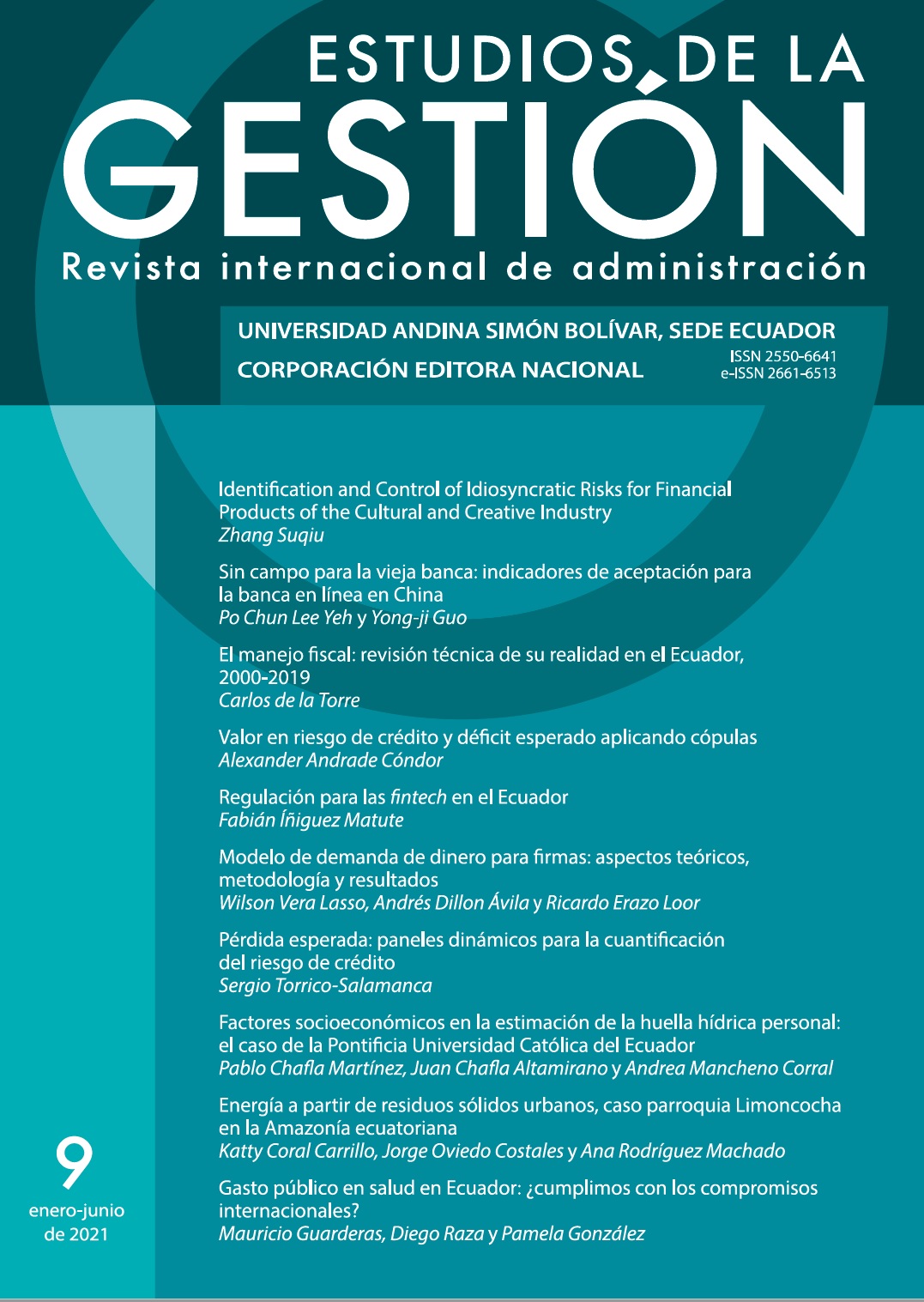Factores socioeconómicos en la estimación de la huella hídrica personal: el caso de la Pontificia Universidad Católica del Ecuador
DOI:
https://doi.org/10.32719/25506641.2021.9.8Palabras clave:
estimación socioeconómica, huella hídrica personal, correlaciones de variables socioeconómicas, indicador agregadoResumen
El presente estudio tiene como objetivo determinar la existencia de correlaciones entre la huella hídrica personal (HH) estimada de manera volumétrica (metros cúbicos/persona), con determinadas variables socioeconómicas como el sexo, la edad, el ingreso familiar, el nivel de educación, el tipo y los años de la vivienda y el número de personas con las que comparten la vivienda. Con una metodología de investigación descriptiva y exploratoria, se realizó una encuesta virtual a finales de 2019 a toda la comunidad universitaria de la Pontificia Universidad Católica del Ecuador (docentes, administrativos y alumnos) en la sede principal de la ciudad de Quito. También se dejó abierta la posibilidad de que personas fuera de la universidad pudieran llenar la encuesta y de esta manera poder evaluar si el consumo de los miembros de la comunidad universitaria que habían recibido información sobre uso sustentable del agua, presentaba alguna diferencia con las personas que no la habían recibido. Se encontró que existe una correlación significativa entre la HH y algunas de las variables socioeconómicas analizadas como el ingreso familiar, el sexo y el nivel educativo. Se desprende también de la investigación que la HH puede ser utilizada como un buen indicador agregado de consumo de agua que ayude a tomar conciencia sobre patrones insostenibles de consumo, mas no es recomendable su utilización como instrumento para la gestión y planificación hidrológica por la concentración y sencillez de la información que presenta.
Descargas
Referencias
Boggiano, Miguel. 2015. “Los 10 países con más reservas de agua en el mundo”. Revista Diplomacia 129: 16-19.
Chapagain, Ashok, y David Tickner. 2012. “Water Footprint: Help or Hindrance?”. Water Alternatives 5 (3): 563-581. https://bit.ly/2ZL1sMo.
Food and Agriculture Organization of the United Nations (FAO). 2003. Water Reports 23: Review of World Water Resources by Country. Accedido abril de 2020. https://bit.ly/2U6r-1Vg.
---. 2016. Aquastat. https://bit.ly/2Mpmxow.
Garrido, Alberto M., Ramón Llamas, Consuelo Varela-Ortega, Paola Novo, Roberto Rodríguez-Casado y Maite Aldaya. 2010. Water Footprint and Virtual water Trade in Spain: Policy Implications. Nueva York: Springer.
Guamán, Juan. 2018. “Estimación de la huella hídrica para la Secretaría del Agua planta central Quito”. Tesis de grado, Universidad Politécnica Salesiana, Quito. https://bit.ly/2XYyO93.
Hernández-Sampieri, Roberto, y Christian Mendoza. 2018. Metodología de la investigación. Las rutas cuantitativa, cualitativa y mixta. Ciudad de México: McGraw-Hill.
Hoekstra, Arjen, Ashok Chapagain, Maite Aldaya y Mesfin Mekonnen. 2011. The Water Foodprint Assessment Manual. Londres: Earthscan.
Hoekstra, Arjen, y Ashok Chapagain. 2006. “Water Footprints of Nations: Water Use by People as a Function of Their Consumption Pattern”. Water Resour Manage 21 (1): 35-48.
---. 2008. Globalization of Water: Sharing the Planet’s Freshwater Resources. Oxford: Blackwell Publishing.
Lala, Henry, y Mirian Fernández. 2020. “Análisis de la sostenibilidad mediante huella hídrica de la microcuenca del río Pita, Ecuador”. Tecnología y ciencias del agua 11 (1): 169-234.
https://doi.org/10.24850/j-tyca-2020-01-05.
Lee, Yung-Jaan, Chuan-Ming Tung, Piin-Rong Lee y Shih-Chien Lin. 2016. “Personal Water Footprint in Taiwan: A Case Study of Yunlin County”. Sustainability 8 (11): 1-12;
https://doi.org/10.3390/su8111112.
Llop, Armando, Eduardo Comellas, Mauricio Buccheri, Valeria Mendoza, Patricia Puebla, Alicia Duek, Graciela Fasciolo y Armando Bertranou. 2017. “Sobre el alcance y aplicabilidad de la huella hídrica”. Asociación Argentina de Economía Agraria. Accedido febrero de 2020. https://bit.ly/2U58tVx.
Proyecto Huella de Ciudades. 2014. “Manual para la evaluación de la huella hídrica”. Accedido 4 de febrero. https://bit.ly/2XprO5W.
Water Foodprint Network (WFN). 2016. Accedido enero 2020. http://waterfootprint.org/en/.WF Calculator. 2017.
Metodología de la calculadora de huella hídrica. Accedido enero de 2020. watercalculator.org: https://bit.ly/3ds0Wrn.













